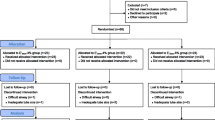Abstract
Otoacoustic emissions (OAEs) are non-invasive, easy to apply and objective test methods which are widely used to determine the presence of hearing in audiology clinics. Under certain circumstances, the study should be applied under general anesthesia. The aim of this study was to determine the influence of new short-acting inhalation agents, desflurane and sevoflurane, on OAE in humans. These short-acting agents are widely used in general anesthesia. Thirty-one healthy patients who underwent septoplasty and turbinoplasty surgery were included in this study. Unpremedicated patients were anesthetized and monitored by a standard protocol except the inhalation agents. Desflurane and sevoflurane were added to the inhaled gas mixture at ~1MAC, 5−6 % and 1.5−2 %, respectively. Transient evoked otoacoustic emissions and distortion product otoacoustic emissions measured in both ears of each patient preoperatively in the operating room before induction, 5 min after induction, after the completion of surgical procedure while the anesthetic agents are still given and 1 h after surgery in the ward. Between-group and within-group comparisons and correlations with hemodynamic parameters were performed for statistical analysis. The measurements of 26 ears in desflurane group and 28 ears in sevoflurane group were evaluated. There were no differences in initial measurements between groups (p > 0.05). Both groups presented significant decrease in intraoperative measurements and changes in time were statistically significant (p < 0.05). The changes in OAEs were similar to changes in systemic blood pressures. Correlation between OAEs and systemic blood pressures were significant (p < 0.05). In conclusion, sevoflurane and desflurane decreased OAEs around 2–3 dB; OAEs are still measurable under inhalation agents. This provides some findings about the OAE status of patient, but the evaluations should be done with the impact of anesthetic agents in mind.




Similar content being viewed by others
References
Cueva RA (2012) Preoperative, intraoperative, and postoperative auditory evaluation of patients with acoustic neuroma. Otolaryngol Clin North Am 45:285–290. doi:10.1016/j.otc.2011.12.002
Schöler C, Schönweiler R, Ptok M (1997) Transitory evoked and distortion products of otoacoustic emissions in absent auditory evoked potentials. HNO 45:1008–1015
Ferber-Viart C, Preckel MP, Dubreuil C et al (1998) Effect of anesthesia on transient evoked otoacoustic emissions in humans: a comparison between propofol and isoflurane. Hear Res 121:53–61
Harel N, Kakigi A, Hirakawa H et al (1997) The effects of anesthesia on otoacoustic emissions. Hear Res 110:25–33
Guven S, Tas A, Adali MK et al (2006) Influence of anaesthetic agents on transient evoked otoacoustic emissions and stapedius reflex thresholds. J Laryngol Otol 120:10–15
Kalay E, Caylan R, Karagüzel A (2004) The effect of propofol and sevoflurane based anaesthesia on otoacoustic emission in pediatric patients. Otoscope 3:85–92. http://www.cty.com.tr/files/journals/4/535.pdf
Kemp DT (2002) Otoacoustic emissions, their origin in cochlear function, and use. Br Med Bull 63:223–241
Liao R, Li J, Liu J (2010) Volatile induction/maintenance of anaesthesia with sevoflurane increases jugular venous oxygen saturation and lumbar cerebrospinal fluid pressure in patients undergoing craniotomy. Eur J Anaesthesiol 27:369–376. doi:10.1097/EJA.0b013e32832edc70
Artru AA, Powers K, Doepfner P (1994) CSF, sagittal sinus, and jugular venous pressures during desflurane or isoflurane anesthesia in dogs. J Neurosurg Anesthesiol 6:239–248
Muzzi DA, Losasso TJ, Dietz NM et al (1992) The effect of desflurane and isoflurane on cerebrospinal fluid pressure in humans with supratentorial mass lesions. Anesthesiology 76:720–724
Patel MP, Drummond JC (2010) Cerebral physiology and the effects of anesthetic drugs. In: Miller RD (ed) Miller’s anesthesia. Churchill Livingstone, Philadelphia, pp 305–339
Mom T, Montalban A, Khalil T, Gabrillargues J, Chazal J, Gilain L, Avan P (2013) Vasospasm of labyrinthine artery in cerebellopontine angle surgery: evidence brought by distortion-product otoacoustic emissions. Eur Arch Otorhinolaryngol. doi:10.1007/s00405-013-2753-0
Morawski K, Telischi FF, Niemczyk K (2006) A model of real time monitoring of the cochlear function during an induced local ischemia. Hear Res 212:117–127
Preckel MP, Ferber-Viart C, Leftheriotis G et al (1998) Autoregulation of human inner ear blood flow during middle ear surgery with propofol or isoflurane anesthesia during controlled hypotension. Anesth Analg 87:1002–1008
Holmström A, Akeson J (2003) Cerebral blood flow at 0.5 and 1.0 minimal alveolar concentrations of desflurane or sevoflurane compared with isoflurane in normoventilated pigs. J Neurosurg Anesthesiol 15:90–97
Mielck F, Stephan H, Weyland A (1999) Effects of one minimum alveolar anesthetic concentration sevoflurane on cerebral metabolism, blood flow, and CO2 reactivity in cardiac patients. Anesth Analg 89:364–369
Kaisti KK, Metsähonkala L, Teräs M et al (2002) Effects of surgical levels of propofol and sevoflurane anesthesia on cerebral blood flow in healthy subjects studied with positron emission tomography. Anesthesiology 96:1358–1370
Bedforth NM, Hardman JG, Nathanson MH (2000) Cerebral hemodynamic response to the introduction of desflurane: a comparison with sevoflurane. Anesth Analg 91:152–155
Author information
Authors and Affiliations
Corresponding author
Rights and permissions
About this article
Cite this article
Gungor, G., Bozkurt-Sutas, P., Gedik, O. et al. Effects of sevoflurane and desflurane on otoacoustic emissions in humans. Eur Arch Otorhinolaryngol 272, 2193–2199 (2015). https://doi.org/10.1007/s00405-014-3124-1
Received:
Accepted:
Published:
Issue Date:
DOI: https://doi.org/10.1007/s00405-014-3124-1




